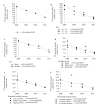Effectiveness of government anti-smoking policy on non-smoking youth in Korea: a 4-year trend analysis of national survey data
- PMID: 28706085
- PMCID: PMC5577913
- DOI: 10.1136/bmjopen-2016-013984
Effectiveness of government anti-smoking policy on non-smoking youth in Korea: a 4-year trend analysis of national survey data
Abstract
Objectives: Since the Health Promotion Act was introduced in Korea in 1995, anti-smoking policies and regulations have undergone numerous revisions, and non-smoking areas have gradually been expanded. The purpose of this study was to examine the impact of a partial legislative ban on adolescent exposure to secondhand smoke using objective urinary cotinine levels in a nationwide representative sample.
Methods: Urine cotinine levels were measured in the Korea National Health and Nutrition Examination Survey from 2008 to 2011. This study was a trend analysis of 4 years of national survey data from 2197 Korean youth aged 10-18 years. Among non-smokers, the 75th percentile urinary cotinine level was estimated. We also considered the number of household smokers.
Results: The 75th percentile urine cotinine level of non-smokers showed a significant decreasing trend from 2008 to 2011, from 15.47 to 5.37 ng/mL, respectively. Urine cotinine did not decline significantly in non-smokers living with smokers during the study period. The results did not show a statistically significant reduction in smoking rate in adolescents from 2008 to 2011, although there was a trend towards a decrease (p=0.081).
Conclusions: Based on urine cotinine levels, government-initiated anti-smoking policies have only been effective among highly exposed non-smoking adolescents during the study period. Further study needs to evaluate whether or not the legislative ban affects domestic smoking exposure.
Keywords: cotinine; environmental tobacco smoke (ETS); vernment-initiated policy.
© Article author(s) (or their employer(s) unless otherwise stated in the text of the article) 2017. All rights reserved. No commercial use is permitted unless otherwise expressly granted.
Conflict of interest statement
Competing interests: None declared.
Figures


Similar articles
-
Decrease in the urine cotinine concentrations of Korean non-smokers between 2009 and 2011 following implementation of stricter smoking regulations.Int J Hyg Environ Health. 2016 Jan;219(1):123-8. doi: 10.1016/j.ijheh.2015.10.001. Epub 2015 Oct 13. Int J Hyg Environ Health. 2016. PMID: 26507969
-
The prevalence of and factors associated with urinary cotinine-verified smoking in Korean adults: The 2008-2011 Korea National Health and Nutrition Examination Survey.PLoS One. 2018 Jun 11;13(6):e0198814. doi: 10.1371/journal.pone.0198814. eCollection 2018. PLoS One. 2018. PMID: 29889856 Free PMC article.
-
Evaluating the effectiveness of the US Navy and Marine Corps Tobacco Policy: an assessment of secondhand smoke exposure in US Navy submariners.Tob Control. 2013 May;22(e1):e66-72. doi: 10.1136/tobaccocontrol-2012-050488. Epub 2012 Aug 7. Tob Control. 2013. PMID: 22871902
-
Urine Cotinine for Assessing Tobacco Smoke Exposure in Korean: Analysis of the Korea National Health and Nutrition Examination Survey (KNHANES).Tuberc Respir Dis (Seoul). 2012 Oct;73(4):210-8. doi: 10.4046/trd.2012.73.4.210. Epub 2012 Oct 31. Tuberc Respir Dis (Seoul). 2012. PMID: 23166556 Free PMC article.
-
Characterization of urinary cotinine in non-smoking residents in smoke-free homes in the Korean National Environmental Health Survey (KoNEHS).BMC Public Health. 2016 Jul 11;16:538. doi: 10.1186/s12889-016-3212-9. BMC Public Health. 2016. PMID: 27401105 Free PMC article.
Cited by
-
Decrease in household secondhand smoking among Korean adolescents associated with smoke-free policies: grade-period-cohort and interrupted time series analyses.Epidemiol Health. 2024;46:e2024009. doi: 10.4178/epih.e2024009. Epub 2023 Dec 13. Epidemiol Health. 2024. PMID: 38186248 Free PMC article.
-
Long-term trends in smoking prevalence and its socioeconomic inequalities in Korea, 1992-2016.Int J Equity Health. 2019 Sep 18;18(1):148. doi: 10.1186/s12939-019-1051-x. Int J Equity Health. 2019. PMID: 31533732 Free PMC article.
-
Exposure to Secondhand Smoke: Inconsistency between Self-Response and Urine Cotinine Biomarker Based on Korean National Data during 2009-2018.Int J Environ Res Public Health. 2021 Sep 2;18(17):9284. doi: 10.3390/ijerph18179284. Int J Environ Res Public Health. 2021. PMID: 34501873 Free PMC article.
References
Publication types
MeSH terms
Associated data
LinkOut - more resources
Full Text Sources
Other Literature Sources
